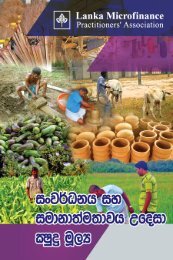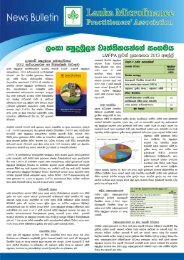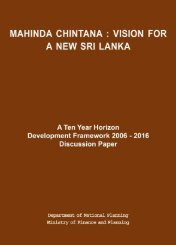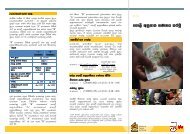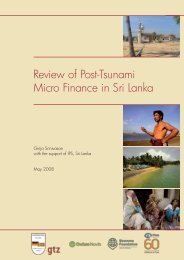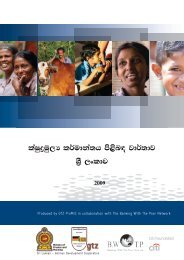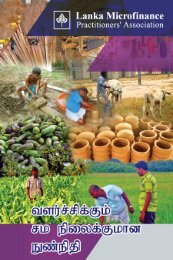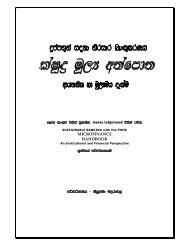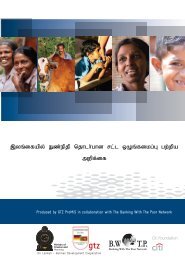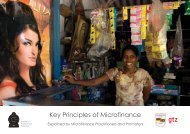National Microfinance Study of Sri Lanka: Survey of Practices and ...
National Microfinance Study of Sri Lanka: Survey of Practices and ...
National Microfinance Study of Sri Lanka: Survey of Practices and ...
Create successful ePaper yourself
Turn your PDF publications into a flip-book with our unique Google optimized e-Paper software.
The dem<strong>and</strong> for loans at the current rate <strong>of</strong> 7% per annum indicates that there are<br />
NGOs that are willing to take loans for micr<strong>of</strong>inance rather than depend on grants<br />
from the donor community.<br />
In year 2000, disbursements from the fund were SLR 263.8 million. This<br />
represents a massive growth from the SLR 52.8 million disbursed in 1998 <strong>and</strong><br />
SLR 87.6 m disbursed in 1999 respectively. Of this, NGOs have borrowed SLR<br />
150.1 million compared to SLR 26.7 million in 1998 <strong>and</strong> SLR 70.1 million in<br />
1999.<br />
Overall, the biggest growth was in year 2000 was by four <strong>of</strong> the Regional<br />
Development Banks. The district wise analysis shows that in as much as 11<br />
districts only 1 or no NGOs beside SEEDS or Sewa <strong>Lanka</strong> took loans.<br />
Moneragala with 6 NGOs <strong>and</strong> Badulla with 5 NGOs, K<strong>and</strong>y with 5 NGOs <strong>and</strong><br />
Ratnapura <strong>and</strong> Kurunegala with 4 each are the other main districts where NGOs<br />
took loans.<br />
The dem<strong>and</strong> for loans was greatest in Anuradhapura with SLR 52.6 million but <strong>of</strong><br />
this as much as SLR 36.6 million was from Rajarata Provincial Bank alone. The<br />
next biggest dem<strong>and</strong> was from K<strong>and</strong>y with SLR 40.8 million where the<br />
K<strong>and</strong>urata Development Bank took SLR 20.4 million <strong>and</strong> a local NGO Kundasala<br />
Praja Sanwardene Padanma took SLR 10.6 million.<br />
Polonnaruwa although having only 3 borrowers had a dem<strong>and</strong> for SLR 27 million<br />
with SEEDS taking SLR 20 million <strong>and</strong> Rajarata Development Bank taking SLR<br />
6.9 million. Badulla also showed a big dem<strong>and</strong> <strong>of</strong> SLR 23.2 million largely due to<br />
SEEDS taking SLR 12.9 million <strong>and</strong> a local agency Economic <strong>and</strong> Rural Services<br />
Bank Service SLR 6.1 million. Moneragala took SLR 19.1 million through 6<br />
separate local NGOs taking loans.<br />
Analysis shows that some agencies or agencies in some districts take loans more<br />
than others are due to their familiarity with <strong>and</strong> knowledge <strong>of</strong> the scheme. For<br />
example the biggest single agency to have taken loans in Rajarata Development<br />
Bank <strong>and</strong> this is due to the fact that its General Manager was a former employee<br />
<strong>of</strong> Janasaviya Trust Fund being the former name for NDTF.<br />
In Moneragala <strong>and</strong> Badulla there has been a larger number <strong>of</strong> NGOs taking loans<br />
as an opinion maker <strong>and</strong> a leader <strong>of</strong> NGOs in the area has initially taken loans <strong>and</strong><br />
advised others to follow suit.<br />
Some large NGOs such as Sewa <strong>Lanka</strong> utilise the loans as part <strong>of</strong> their total<br />
portfolio that is also made up through a large proportion <strong>of</strong> grant funding giving<br />
them the ability to move money from one source to another for repayment<br />
purposes even if the credit itself is not repaid in time. Other agencies such as<br />
SEEDS have good repayment records <strong>and</strong> could borrow more but prefer to<br />
balance grants <strong>and</strong> loans in a financially mature <strong>and</strong> responsible manner.<br />
Only a few TCCS District Unions have been granted loans as 9 district TCCS<br />
Unions are blacklisted for not paying Janasaviya loans. A total <strong>of</strong> 38 NGOs were<br />
granted loans. The NGO survey revealed only approximately one third <strong>of</strong> NGOs<br />
taking loans <strong>and</strong> grants concurrently. This would suggest that many NGOs are<br />
prepared to make the switch from grant in aid to loans <strong>and</strong> the NTDF’s policy <strong>of</strong><br />
charging a 7% interest rate is an effective tactic to successfully encourage NGOs<br />
to change the source <strong>of</strong> funding.<br />
60




